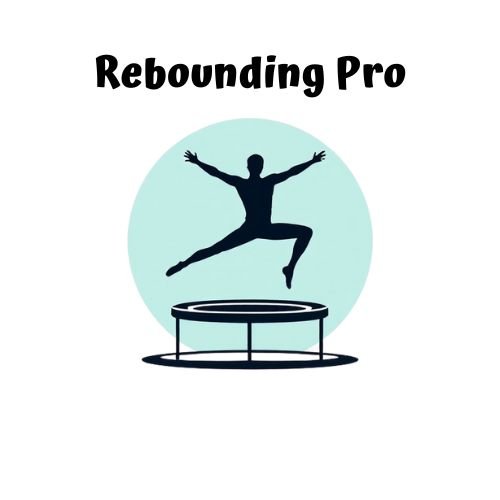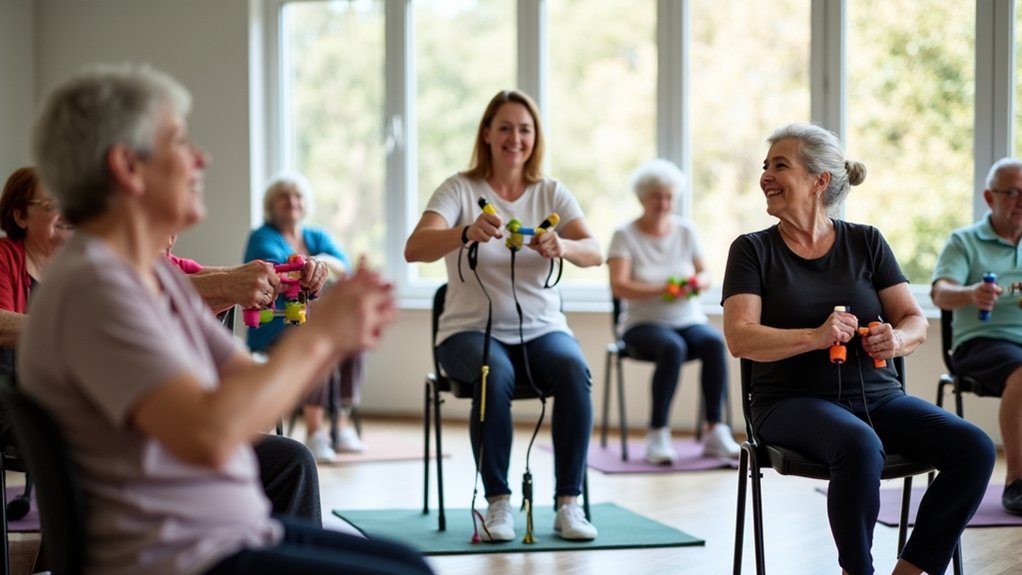Tracking your heart rate during rebounding workouts can transform how you approach fitness on a mini-trampoline. You'll get more precise intensity measurements, improved calorie tracking, and better progress metrics when you monitor your cardiovascular response to these high-impact sessions. But not all heart rate monitors perform equally during the unique bouncing movements of rebounding. The right device must stay in place while delivering accurate readings through jumps and jolts. Let's explore the top five monitors that can keep up with your bounce.
KardiaMobile 6-Lead Personal EKG Monitor for Smartphones
For individuals with cardiac concerns needing medical-grade heart monitoring, the KardiaMobile 6-Lead stands out as an FDA-cleared solution that delivers professional-level insights in just 30 seconds.
This compact device detects AFib, Bradycardia, Tachycardia, and Normal Sinus Rhythm through its stainless steel sensors. You'll appreciate its portability at just 24 grams and impressive 200-hour battery life. While it lacks some features of traditional 12-lead EKGs, you can easily share PDF recordings with your doctor.
Best For: Individuals with existing or suspected heart rhythm conditions who need regular, portable monitoring they can share with healthcare providers.
Pros:
- FDA-cleared device provides medical-grade 6-lead EKG readings in just 30 seconds
- Extremely portable (24 grams) with long 200-hour battery life, requiring no subscription for basic functions
- Creates shareable PDF reports for physician review, detecting AFib, Bradycardia, Tachycardia, and Normal Sinus Rhythm
Cons:
- Lacks the comprehensive capabilities of traditional 12-lead clinical EKGs
- Some users experience a learning curve in obtaining clear readings
- Does not detect heart attacks and may require subscription for advanced features
EZON Heart Rate Monitor Sports Watch with Chest Strap
The EZON Heart Rate Monitor Sports Watch offers simplicity and functionality for fitness enthusiasts who prefer straightforward tracking without smartphone connectivity. Its 5ATM waterproof rating makes it suitable for rebounding workouts and various activities.
You'll appreciate the large display numbers that remain visible during intense cardio sessions. The watch features customizable heart rate zones with audio alerts to keep you in your target range. While some users report occasional connectivity issues between the chest strap and watch, many runners and seniors value its straightforward operation.
For rebounding exercises, the secure chest strap provides consistent readings without the distraction of complex features or app requirements.
Best For: Fitness enthusiasts who prefer simple, smartphone-free heart rate monitoring during various activities including rebounding workouts, running, and cardio exercises, especially seniors or those who value straightforward operation.
Pros:
- 5ATM waterproof rating (50M/164FT) makes it suitable for various activities including swimming and water sports
- Features customizable heart rate target zones with audio and visual alarms to maintain optimal workout intensity
- Large, clear display numbers that remain easily visible during intense exercise sessions
Cons:
- Some users report connectivity issues between the chest strap and watch, affecting reliability of heart rate readings
- Lacks advanced features like average/max heart rate summaries found in higher-priced alternatives
- Mixed reviews regarding comfort, with some users noting discomfort with the watch band buckle
Scosche Rhythm R+2.0 Waterproof Heart Rate Monitor Armband
Fitness enthusiasts seeking a chest-strap alternative will find the Scosche Rhythm R+2.0 Waterproof Heart Rate Monitor Armband an impressive option. This hyper-accurate device features both ANT+ and Bluetooth connectivity, allowing you to pair with multiple fitness apps and equipment simultaneously.
You'll appreciate its versatility during rebounding workouts with its IP68 waterproof rating and impressive 24-hour battery life. The adjustable band fits comfortably on your upper arm (6.7-15.75 inches), eliminating the restrictive feel of chest straps.
While most users report excellent accuracy comparable to chest monitors, some note occasional connectivity issues and customer service challenges.
Best For: Fitness enthusiasts seeking a comfortable, accurate and versatile heart rate monitor alternative to chest straps for high-intensity workouts, swimming, and outdoor training activities.
Pros:
- Hyper-accurate heart rate tracking with dual ANT+ and Bluetooth connectivity allows simultaneous pairing with multiple fitness devices and apps
- IP68 waterproof rating makes it suitable for swimming and extreme workout conditions while the adjustable armband provides comfortable wear
- Impressive 24-hour battery life from a single charge minimizes workout interruptions and maintenance
Cons:
- Some users report intermittent connectivity issues with certain devices despite dual connectivity options
- Customer service responsiveness and support quality have been inconsistent according to user feedback
- While initially reliable, long-term durability and performance consistency may vary between units
KardiaMobile 6-Lead Personal EKG Monitor for Smartphones
Medical-grade heart monitoring becomes accessible with the KardiaMobile 6-Lead Personal EKG Monitor, an FDA-cleared device designed specifically for individuals with existing cardiac concerns or those requiring regular heart rhythm assessment.
You'll get accurate readings in just 30 seconds, detecting AFib, Bradycardia, Tachycardia, and Normal Sinus Rhythm. While not a replacement for a traditional 12-lead EKG, this lightweight 24g device offers impressive convenience with its 200-hour battery life.
The simple interface works with most smartphones via the Kardia app, allowing you to share PDF reports with your doctor. Consider it a supplementary tool that bridges the gap between doctor visits.
Best For: Individuals with existing heart conditions who need regular monitoring between doctor visits, or anyone concerned about potential cardiac arrhythmias who wants a convenient way to track their heart rhythm.
Pros:
- FDA-cleared device provides medical-grade 6-lead EKG readings in just 30 seconds, detecting multiple heart rhythm conditions including AFib
- Highly portable (24g) with impressive 200-hour battery life and compatibility with most smartphones
- Easy to share results with healthcare providers through PDF reports, eliminating the need for in-person visits for routine checks
Cons:
- Not a complete replacement for traditional 12-lead EKGs performed in medical settings
- Requires proper technique and sometimes moisture on the skin for accurate readings
- Basic version lacks some advanced features which may require paid subscription
KardiaMobile 1-Lead Personal EKG Monitor for Smartphones
For athletes concerned about cardiac health beyond basic fitness tracking, KardiaMobile 1-Lead Personal EKG Monitor stands out as a medically-validated solution. This FDA-cleared device captures medical-grade EKGs in just 30 seconds with instant analysis.
You'll appreciate its pocket-sized portability and buttonless design when shifting between workouts. Simply place your fingers on the pads and stay still while it detects Atrial Fibrillation, Bradycardia, Tachycardia, or Normal Sinus Rhythm.
While the basic functionality works without subscription, consider the KardiaCare plan ($99.99/year) for storing multiple readings and additional features. Remember, this complements—not replaces—professional medical advice.
Best For: Athletes and fitness enthusiasts who want medical-grade cardiac monitoring beyond typical fitness trackers, especially those with existing heart conditions or concerns about heart rhythm abnormalities.
Pros:
- FDA-cleared device providing medical-grade EKG readings in just 30 seconds with instant analysis of multiple heart conditions
- Extremely portable with a simple, buttonless design that fits in a pocket and works with most smartphones
- Provides peace of mind with the ability to detect Atrial Fibrillation, Bradycardia, Tachycardia, and Normal Sinus Rhythm
Cons:
- Limited functionality without the KardiaCare subscription ($99.99/year), as only the most recent EKG reading is stored
- Requires consistent finger placement and stillness during readings, with some users reporting weak transmission issues
- Cannot replace professional medical evaluation, as interpretation capabilities have limitations and first-time users must wait for medical review
Factors to Consider When Choosing Heart Rate Monitors for Rebounding Cardio Workouts
When selecting a heart rate monitor for rebounding workouts, you'll need to prioritize models that maintain accuracy during bouncing movements while providing a snug, comfortable fit that won't shift during intense activity. Look for monitors with reliable Bluetooth connectivity that integrate seamlessly with fitness apps to track your progress effectively. Consider battery life carefully, as rebounding sessions can be frequent and lengthy, requiring a monitor that won't die mid-workout.
Subheading Discussion Points
Selecting the right heart rate monitor can dramatically enhance your rebounding workout experience while providing valuable performance data. Look for devices with proven accuracy and reliability to guarantee you're tracking your true workout intensity.
Since rebounding generates significant moisture, choose a waterproof or sweat-resistant monitor that won't fail mid-workout. Real-time monitoring with target zone alerts helps you maintain ideal intensity, maximizing cardiovascular benefits during your sessions.
Comfort is vital during dynamic rebounding movements—opt for a monitor that won't slip or chafe as you bounce. Finally, consider compatibility with your existing fitness apps or equipment to seamlessly track your progress over time. These features will help you get the most from both your monitor and your rebounding routine.
Accuracy During Bouncing Movements
Accuracy becomes the cornerstone issue when choosing a heart rate monitor for rebounding workouts. The rapid up-and-down movements inherent to rebounding can compromise your monitor's ability to capture consistent heart rate data as your body position constantly changes.
Chest straps typically deliver more reliable readings during high-impact rebounding sessions, maintaining closer connection to your heart than wrist-based alternatives. Optical sensors in many wrist monitors struggle during vigorous movements, often resulting in delayed or inaccurate readings.
You'll get better results by calibrating your monitor before each workout session. Most importantly, invest in a device specifically engineered for high-intensity activities. These monitors come equipped with technology designed to handle the unique challenges of bouncing movements, ensuring you'll receive the accurate data needed to optimize your cardio performance.
Comfort and Secure Fit
During high-impact rebounding sessions, a heart rate monitor's comfort and secure fit become as essential as its accuracy. You'll want a monitor that stays in place through all your bouncing movements, as slippage leads to inaccurate readings and disrupts your workout flow.
Look for devices with adjustable straps that accommodate your body size while providing a snug—but not restrictive—fit. Too tight, and you'll experience discomfort that limits your movement; too loose, and you'll get unreliable data.
The best monitors feature lightweight designs with soft, breathable, moisture-wicking materials that prevent chafing during intense rebounding sessions. These comfort features aren't just luxuries—they're practical necessities that allow you to focus on your workout rather than fidgeting with an uncomfortable device.
Connectivity and App Integration
While accurate heart rate readings form the foundation of effective monitoring, today's rebounding enthusiasts need devices that connect seamlessly with their digital fitness ecosystem. Look for monitors offering Bluetooth or ANT+ connectivity that integrate with your favorite fitness apps and gym equipment, enhancing your workout tracking capabilities.
Prioritize devices providing real-time heart rate data that can sync with multiple devices simultaneously, allowing thorough performance monitoring during your rebounding sessions. The best monitors support firmware updates through their companion apps, ensuring you'll always have the latest features and improvements.
Before purchasing, verify compatibility with your preferred fitness platforms to improve data accessibility. Choose monitors that support advanced app features like workout summaries and performance analytics—these tools will help you optimize your rebounding cardio regimen and track your progress effectively.
Battery Life Considerations
Beyond connectivity features, the longevity of your heart rate monitor's power source can make or break your rebounding experience. When selecting a device, look for models offering extended battery life—some provide up to 200 hours on a single battery, minimizing workout interruptions.
Consider monitors with rechargeable batteries that last at least 24 hours per charge, ensuring they'll support multiple weekly sessions without frequent recharging. Alternatively, devices using standard batteries like CR2032 or CR2016 offer convenience through easy replacement.
Remember that battery performance varies depending on which features you're using. Bluetooth connectivity and real-time tracking consume more power, so prioritize monitors that balance functionality with efficiency. To maximize battery life, maintain your device properly by cleaning contacts and ensuring batteries are correctly seated.
Frequently Asked Questions
How Accurate Are Heart Rate Monitors Compared to Medical Devices?
Consumer heart rate monitors aren't as accurate as medical devices, but they're close enough for fitness tracking. You'll find wrist-based ones typically within 5-10% accuracy, while chest straps offer near-medical precision.
Can Heart Rate Monitors Track Calories Burned During Rebounding Workouts?
Yes, most heart rate monitors can track calories burned during rebounding workouts. They'll estimate your energy expenditure based on your heart rate, weight, age, and gender, though these calculations aren't always perfectly accurate.
How Do Rebounding Exercises Specifically Affect Heart Rate Zones?
Rebounding exercises elevate your heart rate quickly, allowing you to efficiently cycle through different zones. You'll notice they're particularly effective at maintaining moderate to high intensity zones while reducing joint impact.
Are Wrist-Based Monitors Reliable for the Bouncing Motions of Rebounding?
Wrist-based monitors can be less reliable during rebounding. You'll experience accuracy issues from the bouncing motion. For better results, you're better off using a chest strap monitor during your bouncing workouts.
What's the Ideal Heart Rate Range for Effective Rebounding Cardio Workouts?
For effective rebounding cardio, aim to keep your heart rate between 70-85% of your maximum (roughly 220 minus your age). You'll maximize fat burning and cardiovascular benefits while still maintaining proper form.





Leave a Reply